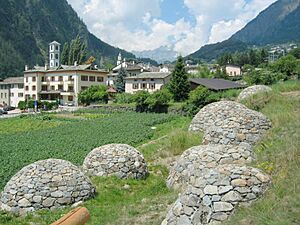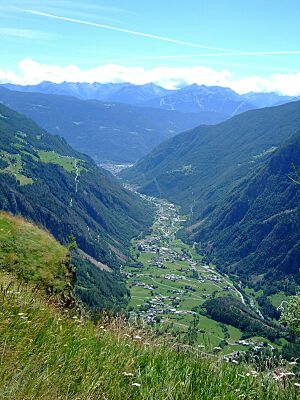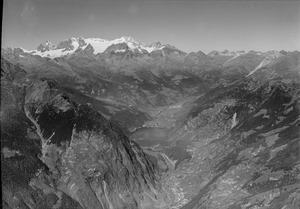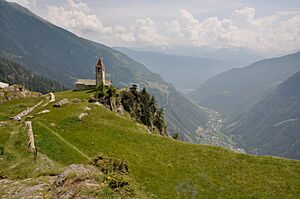Brusio facts for kids
Quick facts for kids
Brusio
|
||
|---|---|---|
|
Municipality
|
||
 |
||
|
||
| Country | Switzerland | |
| Canton | Grisons | |
| District | Bernina | |
| Area
Lua error in Module:Wd at line 1575: attempt to index field 'wikibase' (a nil value).
|
||
| • Total | Lua error in Module:Wd at line 1,575: attempt to index field 'wikibase' (a nil value). km2 (Formatting error: invalid input when rounding sq mi) | |
| Elevation | 780 m (2,560 ft) | |
| Population
(2018-12-31)Lua error in Module:Wd at line 1575: attempt to index field 'wikibase' (a nil value).
|
||
| • Total | Lua error in Module:Wd at line 1,575: attempt to index field 'wikibase' (a nil value). | |
| Time zone | UTC+01:00 (Central European Time) | |
| • Summer (DST) | UTC+02:00 (Central European Summer Time) | |
| Postal code(s) |
7743
|
|
| SFOS number | Lua error in Module:Wd at line 1575: attempt to index field 'wikibase' (a nil value). | |
| Localities | Viano, Cavaione, Campocologno, Campascio, Miralago, Zalende | |
| Surrounded by | Bianzone (IT-SO), Chiuro (IT-SO), Grosotto (IT-SO), Poschiavo, Teglio (IT-SO), Tirano (IT-SO), Vervio (IT-SO), Villa di Tirano (IT-SO) | |
| Website | SFSO statistics |
|
Brusio (which is called Brus in a local language called Lombard: Lombard and Brüsch in Romansh: Romansh) is a town in Switzerland. It's located in the Bernina Region in the canton of Grisons. A canton is like a state or province in other countries.
Contents
History of Brusio
Brusio was first mentioned in old writings in 1106, but it was called Bruse back then. By 1212, it was known as Brusio.
A very old building, the monastery of San Romerio, was built high above the Val Poschiavo valley before the year 1055. A monastery is a place where monks or nuns live and worship. The village of Brusio started to grow on the valley floor below this monastery. The monastery helped the village grow in its early days.
By 1212, Brusio was already an independent town, meaning it could make its own decisions. It even had its own senior pastor who spoke for the town. In the 1200s, the whole Val Poschiavo valley became part of the land controlled by the Bishop of Chur. A bishop is a high-ranking church leader.
Later, in the 1300s, Brusio was part of the larger town of Poschiavo, even though it was mostly independent. Around 1498, Poschiavo (and Brusio with it) joined a group called the League of God's House. This group was part of the Three Leagues, which was an important alliance of regions in Switzerland.
During a time when the Three Leagues took over the Valtellina valley, two small villages, Campocologno (in 1518) and Zalende (in 1526), were founded. Brusio tried to become fully separate from Poschiavo in 1610, but it didn't happen until much later, in 1851. In 1863, two other areas, Saiento and Cavajone, which were part of Italy before, joined Brusio and became part of Switzerland.
Geography of Brusio
Brusio covers an area of about 46.3 square kilometers (17.9 square miles). A big part of this land, about 54.1%, is covered by forests. About 16.6% is used for farming. A small part, 2.3%, has buildings or roads, and the rest (27%) is made up of things like rivers, glaciers, or mountains.
The town is in the Brusio sub-district of the Bernina region. It's located in the Val Poschiavo valley, on the road that goes from the Bernina Pass mountain pass into Italy.
Besides the main village of Brusio, there are several smaller villages or hamlets that are part of the municipality. These include Campocologno, Zalende, Campascio, Piazzo, and parts of Miralago. There are also tiny settlements high up in the mountains called Viano and Cavaione.
People and Population
As of 2015, Brusio has a population of 1,106 people. In 2008, about 7.6% of the people living in Brusio were from other countries. Over the ten years before that, the population went down by about 12.7%.
In 2000, about 48.7% of the people were male and 51.3% were female. Here's a look at the age groups in Brusio in 2000:
- About 9.7% of the population were children aged 0 to 9 years old.
- About 5.9% were 10 to 14 years old.
- About 3.7% were 15 to 19 years old.
- About 9.7% were young adults aged 20 to 29.
- About 16.1% were 30 to 39 years old.
- About 11.8% were 40 to 49 years old.
- About 15.1% were 50 to 59 years old.
- About 12.1% were seniors aged 60 to 69.
- About 10.6% were 70 to 79 years old.
- About 4.7% were 80 to 89 years old.
- And about 0.7% were 90 to 99 years old.
In the 2007 national election, the most popular political party in Brusio was the SVP. They received about 40.8% of the votes. Other popular parties were the SPS, the CVP, and the FDP.
In Brusio, about 61% of adults (aged 25 to 64) have finished either high school or gone on to higher education, like university.
The unemployment rate in Brusio is low, at 1.9%. This means that only a small percentage of people who want to work can't find a job. In 2005, many people worked in farming (107 people), and there were 30 businesses in this area. Many also worked in manufacturing or construction (217 people), with 24 businesses. The largest number of people worked in services (374 people), like shops, hotels, or offices, with 70 businesses.
Based on the 2000 census, most people in Brusio are Roman Catholic (87.5%). About 7.6% belong to the Swiss Reformed Church. A very small number of people are Muslims. There are also some people who belong to other churches or no church at all.
Here's how the population of Brusio has changed over time:
| year | population |
|---|---|
| 1803 | 620 |
| 1850 | 1,000 |
| 1900 | 1,199 |
| 1950 | 1,528 |
| 1960 | 1,445 |
| 1970 | 1,344 |
| 1980 | 1,258 |
| 1990 | 1,220 |
| 2000 | 1,202 |
Languages Spoken
Most people in Brusio speak Italian. In 2000, about 92.4% of the population spoke Italian. German was the second most common language (5.3%), and Portuguese was third (1.0%).
Here's a table showing the languages spoken in Brusio over different years:
| Languages | Census 1980 | Census 1990 | Census 2000 | |||
|---|---|---|---|---|---|---|
| Number | Percent | Number | Percent | Number | Percent | |
| German | 43 | 3.42% | 45 | 3.69% | 64 | 5.32% |
| Romansh | 15 | 1.19% | 12 | 0.98% | 8 | 0.67% |
| Italian | 1,191 | 94.67% | 1,150 | 94.26% | 1,111 | 92.43% |
| Population | 1,258 | 100% | 1,220 | 100% | 1,202 | 100% |
Important Heritage Sites
Some places in Brusio are very important and are listed as Swiss heritage sites of national significance. This means they are protected because of their historical or cultural value. These sites include the Casa di Risch, the Chiesa di San Romerio e dintorni (which is the San Romerio Church), and a group of nine old stone shelters called Gruppo di 9 «Crot».
As mentioned before, the monastery of San Romerio was built high in the hills before 1055. The village of Brusio grew nearby and was greatly influenced by this ancient monastery.
Transportation
Brusio has three train stations: Brusio, Campascio, and Campocologno. All these stations are on the Bernina line, which is a famous train route. You can take a train from here to St. Moritz and Tirano. The town is also famous for the amazing Brusio spiral viaduct, which is a unique curved bridge that trains travel on.
See also
 In Spanish: Brusio para niños
In Spanish: Brusio para niños








